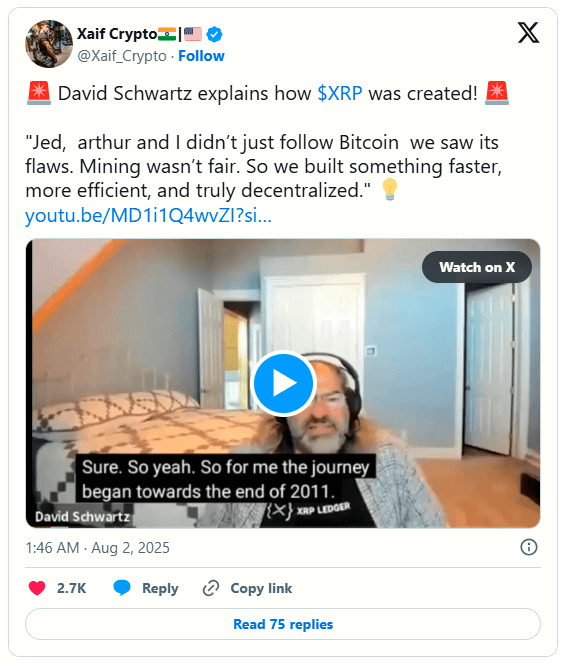Influencer in the cryptocurrency space, Xaif, recently shared a post highlighting Ripple's Chief Technology Officer David Schwartz's detailed article on the origins of the XRP Ledger (XRPL). The post quotes Schwartz, stating that he, along with Jed McCaleb and Arthur Britto, identified key flaws in Bitcoin and sought to design a blockchain system to address those limitations.
According to Xaif's tweet, Schwartz emphasized that the team aims to create something "faster, more efficient, and truly decentralized," differing from Bitcoin's proof-of-work design. Attached to the tweet is a video where Schwartz recounts the timeline and technical foundation that led to the development of XRPL, starting from 2011.

Initial Motivation and Design Philosophy
In the video, Schwartz clarifies that the initial concept originated from Jed McCaleb in 2011, at a time when proof-of-work (PoW) was seen as an essential factor for Bitcoin's success.
Schwartz notes that despite the prevailing sentiment, signs have emerged suggesting that PoW may not be a sustainable or fair blockchain consensus model. He mentioned that one of the initial assumptions was that mining would remain an open process, accessible to anyone with computational ability.
However, over time, it became clear that this model had naturally evolved into a centralized structure favoring the most efficient operators, thereby creating systemic inequality and inherent stakeholders.
Schwartz explains that McCaleb proposed replacing PoW with a distributed agreement algorithm—a method that has long existed in computer science but has largely been unexplored in blockchain systems.
Schwartz began exploring the implementation of this concept in November 2011 to validate whether a blockchain that does not use PoW could operate effectively and what unique properties it could offer.
Breakthroughs and Technical Distinctions
Ripple's Chief Technology Officer (CTO) stated that they quickly discovered this model worked efficiently and offered unique features not present in Bitcoin. Notably, the consensus algorithm used in XRPL is "leaderless," eliminating the need for a single block producer.
Schwartz explains that in systems like Bitcoin or Ethereum, a chosen entity creates each block, which poses the risk of transaction manipulation, especially in use cases like asset exchanges. In contrast, the XRP Ledger does not rely on a designated head, making it particularly suitable for fair and transparent financial operations.
He emphasized that this architectural decision led to the realization that XRPL could serve as a foundation for a decentralized asset exchange.
Arthur Britto soon recognized that the absence of a block producer minimized risks such as front-running, transaction reordering, or selective censorship. As a result, the team designed an exchange where participants could place buy orders and execute trades with lower systemic risk.
Multi-Asset Ledger and Liquidity Pools
Inspired by Ryan Fugger's earlier work in 2004, the team expanded XRPL to support issued assets, which Schwartz describes as the first version of stablecoins. This design combines a decentralized exchange (DEX) and an account-based model, rather than Bitcoin's UTXO model. These changes allow for multi-asset transactions and improve interoperability.
Schwartz points out that even those who believe Bitcoin will dominate global finance must acknowledge the transitional nature of value between different assets. In this context, a multi-asset ledger is necessary. He stated that XRPL was introduced in mid-2012 as a fully-featured platform where users could access public liquidity pools.
The system allows users to hold one asset and make payments using another asset through automatic pathfinding and efficient order routing. He noted that this flexibility addressed the reality that much of the global value is not denominated in Bitcoin or any cryptocurrency.
Completion and Heritage
According to Schwartz, by early to mid-2012, XRPL was essentially complete with core features similar to those today, including an account model, issued assets, XRP as a native currency, and an integrated decentralized exchange.
This technology is built on efficient transaction execution, decentralized liquidity, and practical interoperability across multiple assets. Schwartz concludes that these factors position XRPL as a uniquely capable blockchain platform, especially for financial applications requiring fairness, speed, and decentralization.
